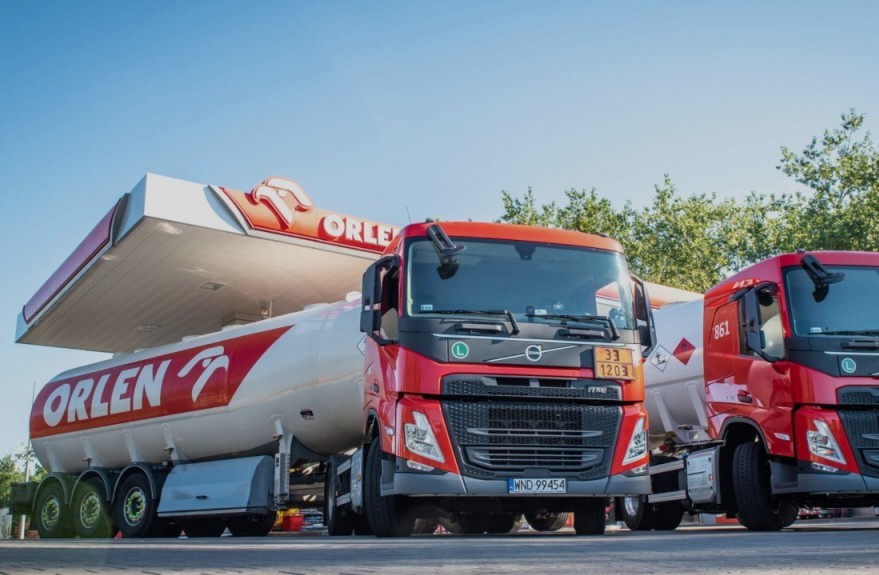By Wojciech Jakóbik
Poland has not abandoned Russian oil entirely, as it declared it would, but instead the Kremlin has turned the taps off itself – perhaps for good. Securing energy independence from Russia, however, is not the end but rather the beginning of new challenges on the Polish market.
Where does Poland get its oil from?
Poland has until now imported crude oil using two main routes: the Druzhba pipeline, stretching from Russia, via Belarus, into Poland (the Polish capacity is 50 million tonnes of oil); and the Naftoport terminal in Gdańsk (with an annual handling capacity of 40 million tonnes), connected by the Pomeranian crude oil pipeline (25 million tonnes) with the Gdańsk (10.7 million tonnes of processing capacity) and Płock refineries (16.3 million tonnes).
The proportion of Russian oil in deliveries to Poland amounted to 95.5% in 2012, 63.1% in 2021 and around 60% in 2022. According to data from February 2022, Poland continued to import approximately 10% of its oil from Russia on the basis of a contract between PKN Orlen and Tatneft, which runs until the end of 2024.
Poland is still getting around 10% of its oil from Russia despite pledging to stop all Russian energy imports by the end of last year, a deputy minister confirms
He says the figure can only be reduced further if the EU introduces an embargo on Russian oil https://t.co/FrE41Rt6vP
— Notes from Poland 🇵🇱 (@notesfrompoland) February 10, 2023
Other provider countries include Saudi Arabia, the United States, Kazakhstan, Nigeria and Norway. Saudi Arabia is the largest of those, with around 20% of the market. After its merger with Lotos, state energy giant PKN Orlen is the only company responsible for importing oil to Poland.
Why is Poland yet to abandon Russian oil?
In March 2022, Prime Minister Mateusz Morawiecki pledged that Poland would completely abandon Russian oil by the end of the year in response to Russia’s invasion of Ukraine. That objective was not achieved.
While the European Union introduced an embargo on Russian oil imports on 5 December 2022, it applies to maritime routes. Poland and Germany’s efforts to include the Druzhba pipeline in the sanctions were not successful because its southern line through Ukraine supplies the Czech Republic, Slovakia and Hungary. These countries opposed an embargo, arguing that they could not abandon Russian oil until 2024.
That would mean that PKN Orlen would also not halt Russian oil supplies until then, as it manages refineries in the Czech Republic through the company Unipetrol. A stoppage in imports from Russia before 2024 could mean fuel shortages in Poland’s neighbouring partner, and would probably entail demand for rail and road deliveries from other sources.
It would also come with other costs, including giving a competitive advantage to other oil firms, such as Hungary’s MOL, that would still be importing Russian crude.
Such issues show the tension between the business objectives of a publicly listed company like PKN Orlen and the priorities of the energy security policy of the state, which is the company’s biggest shareholder.
As it absorbs smaller firms and increases international activity, Polish state oil giant Orlen has a chance to join the European elite.
But the ambitions of CEO Daniel Obajtek and his backers in government will come at a high price, writes @jakubwiech https://t.co/fzwMNhCgtg
— Notes from Poland 🇵🇱 (@notesfrompoland) February 9, 2022
Russia turns off the oil tap itself
The European Union – along with the G7 and Australia – have, however, introduced a maximum price for imports of Russian oil not affected by the embargo.
This is a way of restricting Russia’s income from oil sales given the lack of consensus on a complete embargo on imports. If Russian companies do not conform, their cargo will not be insured and will not be able to reach clients.
Russia has responded to these sanctions with its own countersanctions. In a law that enters into force this month, President Vladimir Putin’s has decreed that the government stop supplies to clients applying a maximum price. However, we can expect Polish entities to adhere to the maximum price, with the result that they might be deprived of Russian oil imports.
Perhaps for this reason, on 26 February it was announced that Tatneft’s supplies of Russian oil to Poland were being halted. At the time of publication, there has been no official explanation for the Russians’ ploy, apart from the position of the oil pipeline operator Transneft stating that the supplier, Tatneft, had not paid for access to the Druzhba pipeline in Russia for deliveries to Poland.
Polish state energy firm Orlen has announced that it will sue Russia for halting oil deliveries to Poland.
Moscow cut off supplies one day after Poland became the first country to donate Leopard tanks to Ukraine https://t.co/bqZfP2e7QT
— Notes from Poland 🇵🇱 (@notesfrompoland) March 6, 2023
It is worth stressing that Poland has imposed the obligation on all firms importing fuel to accumulate stocks sufficient for three months of supply. This law was tested in practice at the time of the so-called dirty oil crisis of 2019, when the Druzhba pipeline was stopped for 49 days due to Russian contamination of crude, for which the Polish side has not yet received compensation. Poland is ready for total cut off from Russian oil.
Nevertheless, oil from Kazakhstan was due to begin flowing through Druzhba in Russia to Germany at a similar time. We must consider the possibility that the Russians are deliberately sowing confusion to once again use energy for political purposes, driving a wedge between Poland and Germany.
The latter country is close to finalising talks on the future of its Schwedt refinery, where Rosneft’s shares were put under German government control last year until 13 March 2023, with the possibility of an extension. Poland expects de-Russification of this facility before it allows non-Russian imports through the Naftoport terminal. Speculation is mounting about Orlen becoming a shareholder in the refinery after the Russians are forced out.
Germany's Schwedt refinery will this month start receiving non-Russian oil deliveries via Poland's port in Gdansk.
Germany took control of the refinery from Russia's Rosneft in September and Poland has agreed to supply it with oil https://t.co/CizY1i88qT
— Notes from Poland 🇵🇱 (@notesfrompoland) January 17, 2023
Divorce with Russia in the oil sector versus the fuel market
Crude oil is used for the production of various oil products, with petrol and diesel fuel being among the most common. Their price determines the competitiveness of the economy. But this depends not only on the security of oil supplies and its stock market quotes.
Also important is fuel supply, which is affected by the processing capacity of the refineries providing the product. In 2022, Polish refineries worked at almost full capacity, processing various types of crude oil.
PKN Orlen’s record revenue recorded last year as a result of the prices elevated by the energy crisis (so-called windfall profits) also stemmed from the price differential between the purchased Russian Urals blend crude oil and the products of the work of refineries sold with a corresponding margin depending on the market situation.
A public transport operator has called for an antitrust investigation into the "thieving monopoly" of state oil giant Orlen, saying it inflates prices
Opposition parties have issued similar demands, but the PM argues that Orlen has helped keep prices down https://t.co/Xvonrfkyz7
— Notes from Poland 🇵🇱 (@notesfrompoland) January 3, 2023
This situation was difficult given the production hiccups of the pandemic and the extinguishing of refining capacity in anticipation of energy transition in Europe, as well as falling demand for fuels that is already visible in the west of the continent.
These phenomena, however, were compounded by Russia’s invasion of Ukraine, elevating fuel demands through warfare supported by supplies of raw materials from the West, including Poland. Refining capacity fell before the invasion, and immediately afterwards became more necessary overnight. This challenge has increased fuel prices at filling stations.
Is the oil and fuel market in Poland transparent?
Among the reasons for the increase in prices at filling stations in Poland was the need to accelerate the diversification of oil supplies, but also the embargo on petroleum products from Russia in place since 5 February 2023.
It is important to note that PKN Orlen abandoned imports of such products from Russia as early as spring 2022 on its own, unlike many other European companies, some of which maximised purchases from Russia with the intention of amassing stocks before the embargo came into force.
While official data on this subject can be found at the Industrial Development Agency and Energy Market Agency, there is a charge for access, which has a negative effect on transparency and analysis of this subject.
That has made it more difficult to accurately assess criticism of Orlen over prices at Polish filling stations that have not followed those recorded in other countries, as well as the firm’s rejection of those accusations.
Poland’s Supreme Audit Office is seeking charges against the country’s largest company, energy giant Orlen, after the firm refused attempts by NIK to audit it.
Orlen argues that the audits had no legal basis and it therefore could not cooperate with them https://t.co/nG55wR8b75
— Notes from Poland 🇵🇱 (@notesfrompoland) February 1, 2023
Reform of the Polish oil and fuel sector
The process of the Polish market’s separation from Russian oil should be accompanied by increased transparency of the sector by way of making information on the use of the oil infrastructure and market transactions available to public opinion following the model of energy and gas markets elsewhere in the European Union.
Also needed is a reform of PKN Orlen’s management allowing the Polish state to maintain control over the instruments essential for assuring security of supplies within the entity that will replace the existing ones after the reorganisation associated with the merger of Orlen and Lotos as well as the takeover of PGNiG.
It is worth following the example of the latter company, which operates on the stock market and at the same time has a provision in its charter about its obligation to seek energy security. An extreme example is the operator of the oil transmission infrastructure, PERN, which is 100% owned by the State Treasury. A joint-stock company in the form of PKN Orlen does not have such provisions and thus is not obliged to ensure security.
Norway's sovereign wealth fund, which holds a stake in Orlen, recently put the Polish state oil firm under observation over concerns that its purchase of media outlets creates the "serious risk of political influence in connection with elections" https://t.co/KnQAAeTiQD
— Notes from Poland 🇵🇱 (@notesfrompoland) March 7, 2023
This concern is therefore up to the will of the board. It is there today, but might not be tomorrow. A temporary solution applied by the Polish government to formally guarantee safety of imports is the agreement of 20 July 2022, a declaration of implementation of Poland’s energy policy for oil and liquid fuels.
This is supposed to bring about further diversification and independence from Russia and make the market stronger. But it is not a legally binding declaration. As a result, even after the departure from Russian oil and fuels, it will be essential to reorganise the market after the PKN Orlen-Lotos merger to assure the security of imports.
A number of solutions are in the offing, from the nationalisation of Orlen to the transfer of relevant assets to a company under effective state control.
This reform, like the merger, will take place in conditions of uncertainty resulting from the war in Ukraine as well as global market disruptions that make linear forecast of trends difficult. Parting with Russian oil is not the end of the challenges on the Polish market, but only the beginning.
The Baltic Pipe, an idea first conceived in 1991, has finally begun pumping gas from Norway to Poland via Denmark.
The pipeline will bolster both Poland's security and Europe's efforts to wean itself off Russian gas, writes @wjakobik https://t.co/VEnKo14e8Q
— Notes from Poland 🇵🇱 (@notesfrompoland) December 5, 2022
Main image credit: Orlen press materials
Translated by Ben Koschalka





















